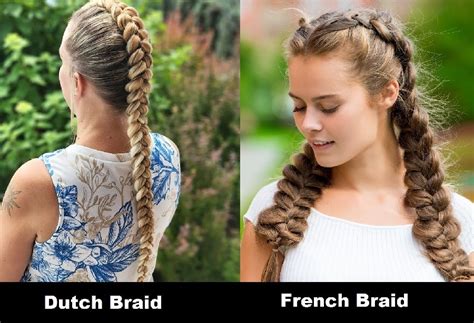Introduction
Braids, an ancient and versatile form of hair styling, have graced the heads of countless individuals throughout history. Among the plethora of braiding techniques, two stand out: the Dutch braid and the French braid. Both styles have their unique charm and appeal, leaving many wondering which one reigns supreme. This article aims to provide an in-depth comparison of Dutch and French braids, exploring their techniques, benefits, and drawbacks to assist you in making the perfect choice for your next hairdo.

Techniques
Dutch Braid:
The Dutch braid, also known as a reverse French braid, is created by taking three strands of hair and crossing the right strand under the middle strand, then the left strand under the new middle strand. This process is repeated, leading to a raised braid that appears to sit on top of the head.
French Braid:
In contrast, the French braid involves crossing the right strand over the middle strand, followed by the left strand over the new middle strand. This technique results in a flat braid that lies seamlessly against the scalp.
Benefits
Dutch Braid:
- Volume: The Dutch braid’s raised structure adds instant volume and fullness to hair, making it an excellent choice for those seeking a more voluminous look.
- Durability: Due to its tight and sturdy construction, the Dutch braid is highly durable, making it suitable for active individuals or those who want a braid that lasts all day.
French Braid:
- Elegance: The French braid exudes an air of sophistication and elegance, making it perfect for formal events or special occasions.
- Versatility: The French braid can be styled in a variety of ways, including buns, ponytails, and half-up hairstyles, offering greater versatility than the Dutch braid.
Drawbacks
Dutch Braid:
- Scalp Tension: The Dutch braid’s raised design can sometimes create tension on the scalp, leading to discomfort or even headaches for some individuals.
- Complexity: Learning to braid Dutch braids can be more challenging than French braids, requiring more practice and dexterity.
French Braid:
- Flatness: The French braid’s flat nature can be less flattering for individuals with fine or thin hair, as it can accentuate the scalp’s appearance.
- Looseness: French braids are typically less secure than Dutch braids, making them more prone to loosening or falling apart throughout the day.
Pros and Cons at a Glance
| Feature | Dutch Braid | French Braid |
|---|---|---|
| Volume | High | Low |
| Versatility | Moderate | High |
| Durability | High | Moderate |
| Complexity | High | Moderate |
| Scalp Tension | Potential | Unlikely |
| Flatness | Unlikely | Potential |
Which One to Choose?
The choice between a Dutch braid and a French braid ultimately depends on individual preferences and the desired outcome. For those seeking a voluminous and durable braid that adds extra height and fullness, the Dutch braid is the way to go. However, if elegance, versatility, and a flatter appearance are prioritized, the French braid is the superior option.
Table 1: Key Features of Dutch and French Braids
| Feature | Dutch Braid | French Braid |
|---|---|---|
| Technique | Cross under, raise | Cross over, flat |
| Volume | High | Low |
| Versatility | Moderate | High |
| Durability | High | Moderate |
| Scalp Tension | Possible | Unlikely |
| Flatness | Unlikely | Possible |
Table 2: Benefits of Dutch and French Braids
| Benefit | Dutch Braid | French Braid |
|---|---|---|
| Adds volume | Yes | No |
| Durable | Yes | Partially |
| Elegant | Partially | Yes |
| Versatile | Partially | Yes |
Table 3: Drawbacks of Dutch and French Braids
| Drawback | Dutch Braid | French Braid |
|---|---|---|
| Scalp tension | Possible | Unlikely |
| Complexity | High | Moderate |
| Flatness | Unlikely | Possible |
| Looseness | Unlikely | Possible |
Table 4: Comparison of Pros and Cons
| Pros | Dutch Braid | French Braid |
|---|---|---|
| Volume | High | Low |
| Durability | High | Moderate |
| Elegance | Moderate | High |
| Versatility | Moderate | High |
| Complexity | High | Moderate |
| Cons | Dutch Braid | French Braid |
|---|---|---|
| Scalp Tension | Possible | Unlikely |
| Flatness | Unlikely | Possible |
| Looseness | Unlikely | Possible |
Applications and Inspirations
Dutch and French braids have countless applications, from everyday hairstyles to formal events. They can be incorporated into buns, ponytails, updos, and even crowns. The following are a few original ideas to spark your creativity:
- Dutch Braid Waterfall: A stunning variation that involves creating a series of Dutch braids that cascade down the side of the head like a waterfall.
- French Braid Accent: Add a touch of elegance to a simple ponytail by braiding a narrow French braid down the center or along the sides of the tail.
- Dutch Braid Halo: Create a unique and eye-catching crown by interlacing Dutch braids around the head, forming a halo-like shape.
Conclusion
Whether you prefer the voluminous and durable Dutch braid or the elegant and versatile French braid, the choice is ultimately yours. By understanding the techniques, benefits, and drawbacks of each style, you can confidently select the perfect braid to suit your individual needs and preferences. Embrace the beauty of braids and elevate your hairstyle game to the next level.
